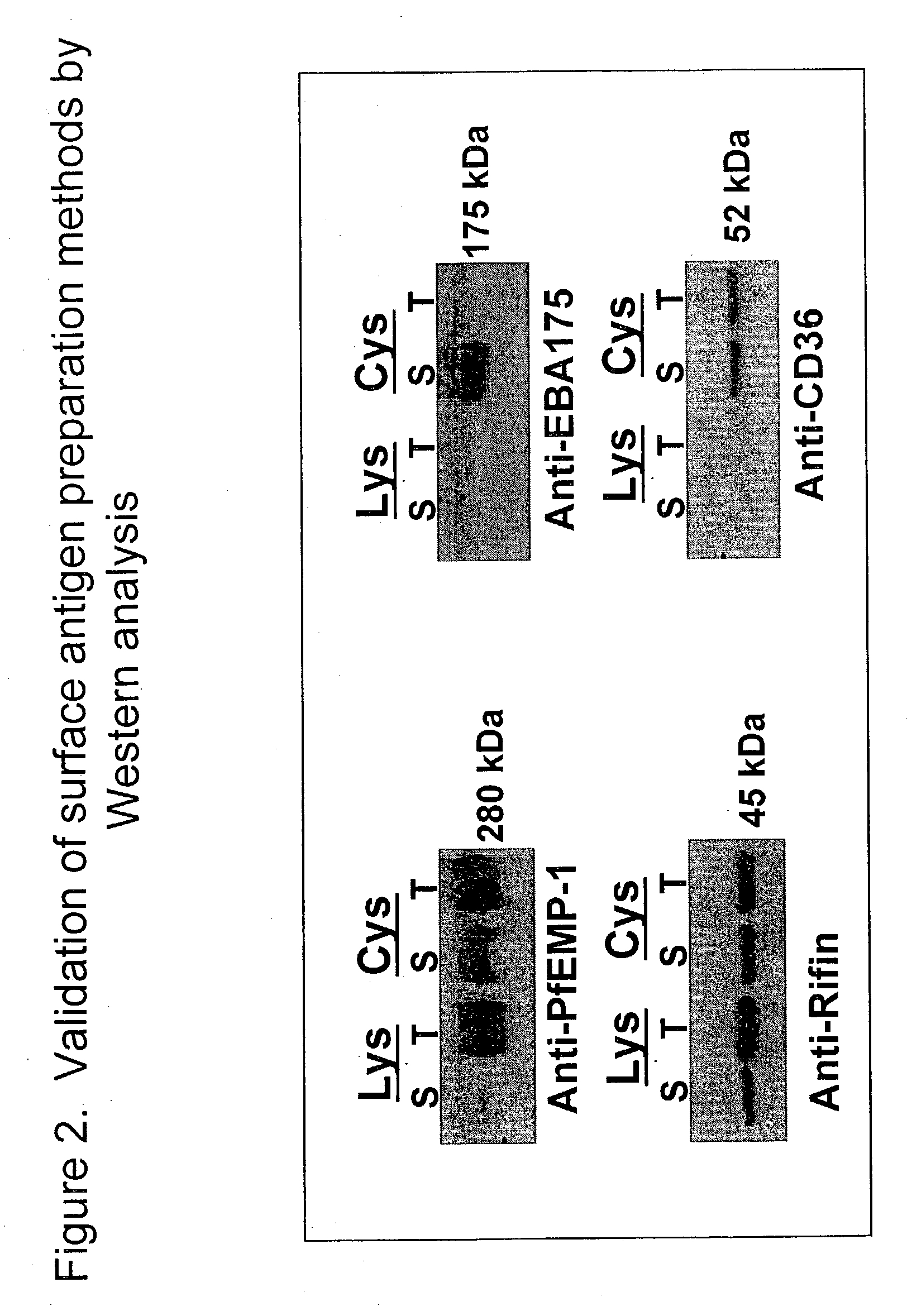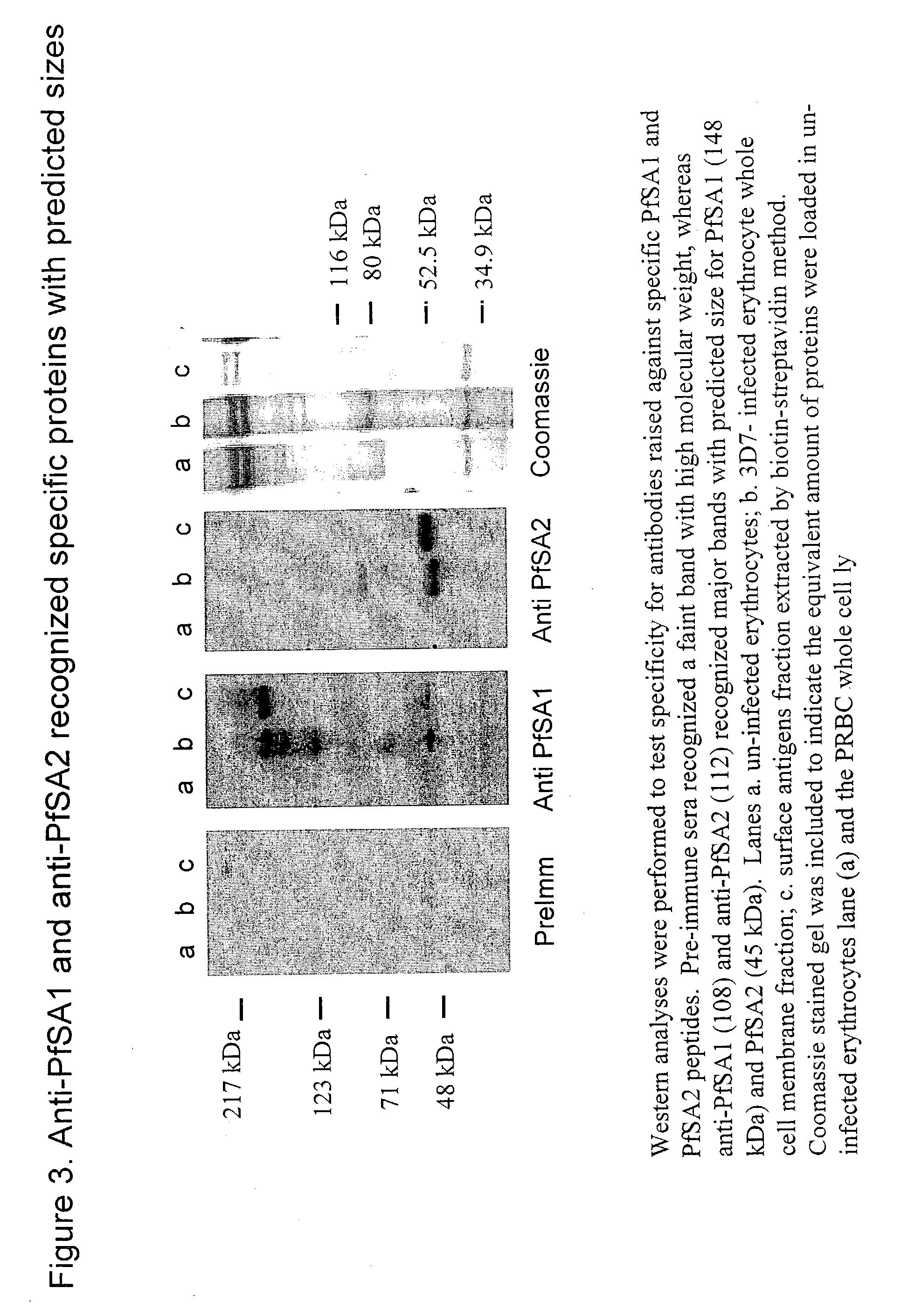Antigens and their use as diagnostics and vaccines against species of plasmodium
a technology of plasmodium and antigens, which is applied in the direction of antibody medical ingredients, instruments, drug compositions, etc., can solve the problems of reducing the clinical effect of the host, limiting the number of parasites in the blood, and not progressing to the pathogenic blood stag
- Summary
- Abstract
- Description
- Claims
- Application Information
AI Technical Summary
Benefits of technology
Problems solved by technology
Method used
Image
Examples
example 2
Identification of P. falciparum Proteins From the Purified Parasitized Red Cell Preparation
[0038] The biotin-labeled fraction was digested with trypsin and endopeptidase C, and loaded onto biphasic microcapillary columns installed such as to spray directly into a ThermoFinnigan LCQ-Deca ion trap mass spectrometer equipped with a nano LC electrospray ionization source. Fully automated 12.quadrature.step chromatography runs were carried out. SEQUEST was used to match MS / MS spectra to peptides in a sequence database combining Plasmodium falciparum and mammalian protein sequences (to account for contaminating host proteins). The validity of peptide / spectrum matches was assessed using the SEQUEST.quadrature.define-d parameters cross-correlation score (XCorr), Delta Cn valuer Sp rank and relative ion proportion. DTASelect (Eng, McCormack, et al 1994) was used to select and sort peptide / spectrum matches passing a conservative set of those parameters. Peptide hits from multiple runs were co...
example 3
Bioinformatic Characterization of PfSA1 and PfSA2
[0041] The informatics package contained within a suite of informatics computer programs on the website www.plasmodb.org were used to characterize the selected proteins. Gene model prediction used GlimmerM (Salzberg, Pertea et al. 1999). PfSA1 is a hypothetical acidic protein of 1297 amino acids with theoretical molecular weight (MW) of 154 kDa and isoelectricfocusing point (IP) of 5.14. It is encoded by a single copy gene 3885 nucleotides long, denoted PfC0435w, located on P. falciparum chromosome 3 (nucleotide positions 444174-448058) and has an orthologue in P. knowlesi.
[0042] PfSA2 is a hypothetical protein of 408 amino acids with theoretical MW of 49 kDa and IP 6.67. It is encoded by a single copy two exon gene near the telomeric region of chromosome 5 (nucleotide sequences 64605-64133 and 64332-65489). It does not have discernible orthologues in other organisms (BlastP cut-off E value of 10.sup.-15). Both PfSA1 and PfSA2 are hig...
example 4
Production of PfSA1- and PfSA2-Specific Antisera.
[0043] Rabbit antisera were raised against synthetic peptides designed based on PfSA1 and PfSA2. The peptide sequence used for PfSA1 is NNSKFSKDGDNEDFNNKNDLYNPSDKLYNN (SEQ ID NO:5). The peptide sequence used for PfSA2 is YEIMHKEDESKESNQHNYKEGPSYEDKKNMYKE (SEQ ID NO:6). Two specific antibodies, denoted 108 and 112, recognized proteins corresponding to the theoretical MW of PfSA1 and PfSA2, respectively, in the whole cell lysate and the biotin-labeled fraction (FIG. 3).
PUM
| Property | Measurement | Unit |
|---|---|---|
| Fraction | aaaaa | aaaaa |
| Composition | aaaaa | aaaaa |
| Immunogenicity | aaaaa | aaaaa |
Abstract
Description
Claims
Application Information
 Login to View More
Login to View More - R&D
- Intellectual Property
- Life Sciences
- Materials
- Tech Scout
- Unparalleled Data Quality
- Higher Quality Content
- 60% Fewer Hallucinations
Browse by: Latest US Patents, China's latest patents, Technical Efficacy Thesaurus, Application Domain, Technology Topic, Popular Technical Reports.
© 2025 PatSnap. All rights reserved.Legal|Privacy policy|Modern Slavery Act Transparency Statement|Sitemap|About US| Contact US: help@patsnap.com



